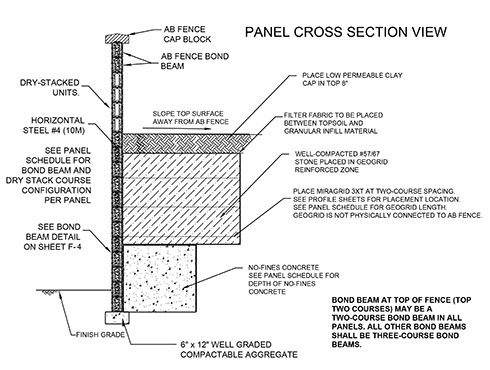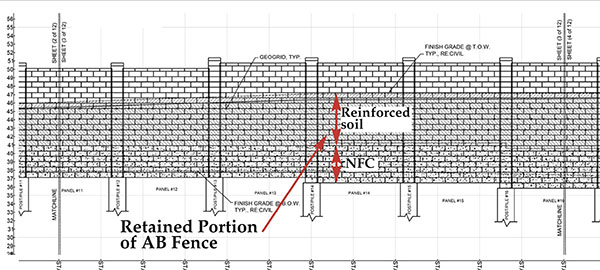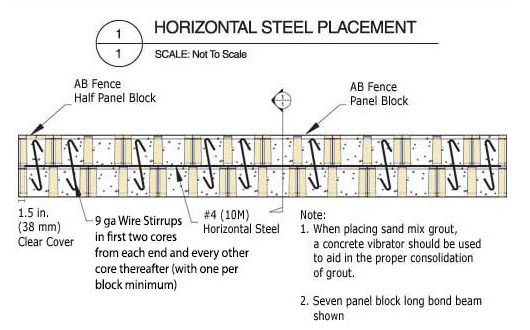Technical Newsletter
Issue 40
AB Classic and AB Fence Retaining Soil
to Create Site Solution
The Springs at Eagle Bend is a luxurious apartment community located just outside of Denver in Aurora, CO. Because of the existing infrastructure and addition of many corporations, the community has seen an explosion of residential and retail developments. Local codes require noise abatement walls (or sound barriers) in many areas to protect current and future residents from the increase in community activities. The Springs at Eagle Bend complex lies adjacent to the existing E-470 Expressway and National Real Estate Developer, Continental Properties found themselves searching for a solution to such a noise abatement requirement for their new development.
To reduce noise pollution, it was determined that a sound barrier of approximately 16 ft in height (5 m) would need to be constructed. In the exact location of the noise wall, a 12 ft grade change (3.5 m) needed to be resolved. A third set of site problems would require 12 traditional retaining walls to compensate for various grade changes of up to 14 ft in height (4.25 m). The goal was to find a common system to solve the various site challenges and Allan Block products manufactured by Basalite Concrete Products in Denver provided just the solution!
Local Allan Block Master Wall Builders, Slaton Brothers, were retained by Continental Properties to assist with solving the various site problems and they immediately hired Steve Kelley, PE of SK Wall Design to assist with the solution and to complete the engineering for all walls onsite. Together, they were tasked with using their knowledge of various site solutions to solve the many challenges present at the Springs at Eagle Bend. One of the most difficult steps was identifying a product that could perform as a retaining and sound wall solution that also complimented the remaining retaining walls on-site. Both were up for the challenge and the result was a perfect blend of AB Classics for the retaining walls and AB Fence for the noise abatement AND some retaining wall portions.

Figure 1
SK Wall Design worked with the engineering department at Allan Block on the AB Fence solution for the Springs at Eagle Bend. The final design was unique, but basic principles that have been used on various other AB projects helped solve the complex site.
No-Fines Concrete (NFC) has been used for 20+ years with Allan Block retaining walls and geogrid has been used for 35+ to reinforce soil behind segmental retaining walls. On the Springs at Eagle Bend project, both NFC and geogrid reinforced soil were used behind the AB Fence to ensure it would withstand the soil pressures. In most fence sections, SK Wall Designs created a CCS (Complex Composite Structure). A CCS is a single wall section with two distinctly different structures positioned one on top of the other. In this case and in most sections, you have NFC working within the bottom portion of the wall with geogrid reinforced earth sections directly on top (see Figure 1). The result created a structure with up to 5 ft high (1.5 m) x 5 ft depth (1.5 m) of NFC with geogrid depths of up to 7 ft (2.1 m) on top of the NFC to create the reinforced earth portions (see Figure 2).
In addition to the use of NFC and geogrid, other unique characteristics to this design when compared to a traditional AB Fence included:

Figure 2
- Rather than traditional two-course bond beams at the top and bottom (most common) the entire panel height reinforcing earth was constructed as a bond beam (in three-course lifts). This required rebar (#4) placed horizontally throughout the entire panel length and in between each course of block.
- “S” hooks, or stirrups made of 9-gauge wire were placed in every block core throughout the length of each bond beam and in three course “lifts”.
Using their knowledge on AB Fence and AB retaining walls, Slaton Brothers with support from Steve Kelly successfully completed the construction of all walls onsite. Their experience was tested due to non-design related issues such as minimal room behind the AB Fence to work (for placement of NFC and reinforced earth) and bedrock (not clay) much closer to the surface than previously thought based on soil borings. These challenges required close communication and joint effort from all parties to ensure the construction lived up to Continental Properties expectations. Using multiple Allan Block products along with SK Wall Design and Slaton Brothers expertise and attention to detail, the various site challenges were solved!
See the Springs at Eagle Bend case study for more information and photos.

Figure 3

Figure 4
What Does a Traditional Fence Include
A traditional AB Fence system uses a post and panel methodology. The posts are set on concrete piles with depth and widths dictated by:
- Wall height
- Post spacing
- Soil conditions
- Wind or seismic considerations (whichever is greater)
The concrete piles and hollow core AB Fence Post Blocks are typically reinforced with four pieces of rebar running vertically the entire height of the pile and post combination, see Figure 3. On some projects a steel reinforcement cage is installed in the pile footing as well. Post spacing is traditionally dictated by wind speeds or seismic considerations (whichever is greater). The further the posts can be separated the more economical the AB Fence most often becomes. Panels are made up of individual blocks (panel blocks) that rest within a recessed channel on each side of the posts, see Figure 4.
The panels are not physically connected to the posts but must have a minimum of 1 in. (25 mm) inset. Bond beams are created within each panel by laying rebar (traditionally #4 bar) horizontally between the two courses of block making up the beams and then filling the hollow cores of the panel block with a fine mix grout and nine-gauge wire stirrups within the entire height of the beam, see Figure 5.

Figure 5
At a minimum, each panel requires a bond beam on the bottom two courses and top two courses, but bond beam placement will be dictated by post spacing, panel height and wind or seismic considerations (whichever is greater) in almost all cases. These methods create a free-floating system that provides noise abatement solutions and aesthetics many owners are seeking. For more on proper design and construction of an AB Fence, check the Installation Manual for the Allan Block Fence System.
How is AB Fence Used to Retain Soil
When AB Fence is required to retain soil, the concern is how to deflect lateral pressure from the retained soil. There are many things to consider and review when designing an AB Fence that will also be retaining soil.
First, Allan Block traditionally recommends the creation of bond beams the entire height of the retained soil. This may be done with two course bond beams or as seen on the Springs at Eagle Bend, AB Fence with three-course bond beams that are stacked on top of one another. These bond beams, like a traditional fence, may be cast in place, or offsite and lifted into place.
Second, to reduce the likelihood of panel bowing, it is an Allan Block recommendation to build the entire AB Fence from bottom to top and allow the concrete in the hollow post blocks and fine grout within each bond beam to cure before backfilling and compacting aggregates. This will reduce additional pressures from placement of material and even compaction of such material.
Third, a designer needs to consider how they are going to reinforce the soil behind the structure. This is not a cast-in-place retaining wall with a cantilever footing. The retaining wall will use similar principles to that of a Segmental Retaining Wall (SRW) so design of such a structure will be very comparable. Using methodologies from the SRW community, one could use solutions including:
- Geogrid reinforced soil masses. This has been a very common practice allowing the weight of the reinforced soil and concrete block facing to resist the acting forces. By using geogrid, AB Fence can be used to construct significant retaining walls as evident at The Springs at Eagle Bend.
- No-Fines Concrete (NFC) applications. When using NFC, one will be able to design and construct taller gravity walls. NFC is a superior backfill material with a very high internal friction angle. When used with AB products, the result is a retaining wall with less of a “footprint” when compared to a geogrid reinforced structure. This may be beneficial on numerous sites with limited excavation capabilities, poor soils or even taller retaining sections such as at the Springs at Eagle Bend.
- Gravity wall structures. Again, very common with SRWs and an application where we use only the weight of the concrete block and setback to resist the acting forces. With a vertical wall such as AB Fence, the height of a gravity wall will most often be very short.
Whatever your challenge, Allan Block has a wall solution for your site. If you are curious about a problem you are experiencing on a site, whether it is a grade change, noise issue or simply a need for an aesthetic wall solution for decorative purposes, we have a solution for you. Feel free to call us today to discuss.
Why use AB Fence?
As evident by use on the Springs at Eagle Bend project, reasons for using AB Fence are plentiful, but sound abatement certainly ranks towards the top. Independent testing has shown that using AB Fence translates into a 32dB transmission loss. When compared to wood or metal products that range from the low teens to mid-twenties you will see why many people prefer AB Fence. In addition to the phenomenal structural performance, the added aesthetic and low maintenance make AB Fence a winning solution!

Plan Your Fence Layout
Allan Block has tools available to make it easy to draw your fence panels. The AutoCAD Fence Macro allows you to configure your panels to fit any project requirements. It helps lay out multiple panels, detailed panel drawings, panel sections, and post sections. Download the Allan Block Fence Macro for AutoCAD to quickly lay out standard pattern and Ashlar pattern fence designs.
ABU Online

In addition to and in support of local market education with our production partners, we have recently started an online platform for education on various site solutions including AB Fence and AB SRWs. These events will be the last Thursday of each month at 10 AM and 2 PM CST and many will provide continuing education opportunities. Topics will range from SRW Engineering Principles, No-Fines Concrete, GRS-IBS, Basic Design and Build of AB Fence, AB Walls Design software among many others. Be sure to check out our ABU Online training opportunities.


